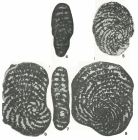Foraminifera taxon details
Pseudospirocyclina Hottinger, 1967 †
738665 (urn:lsid:marinespecies.org:taxname:738665)
accepted
Genus
Pseudospirocyclina maynci Hottinger, 1967 † (type by original designation)
marine, brackish, fresh, terrestrial
fossil only
feminine
Hottinger, L. (1967). Foraminifères imperforés du Mésozoique marocain. <em>Notes du Service Géologique du Maroc.</em> 209: 1-168.
page(s): pp. 70, 73 [details] Available for editors [request]
[request]
page(s): pp. 70, 73 [details] Available for editors
Hayward, B.W.; Le Coze, F.; Vachard, D.; Gross, O. (2024). World Foraminifera Database. Pseudospirocyclina Hottinger, 1967 †. Accessed at: https://www.marinespecies.org/Foraminifera/aphia.php?p=taxdetails&id=738665 on 2024-04-23
Date
action
by
original description
Hottinger, L. (1967). Foraminifères imperforés du Mésozoique marocain. <em>Notes du Service Géologique du Maroc.</em> 209: 1-168.
page(s): pp. 70, 73 [details] Available for editors [request]
[request]
page(s): pp. 70, 73 [details] Available for editors
From editor or global species database
Diagnosis Test free, large, compressed, planispirally enrolled, megalospheric test with simple proloculus followed by juvenile enrolled chambers, microspheric test with more numerous whorls and larger adult test, juvenile whorls involute, chambers low, strongly arched, whorl enlarging rapidly to produce a flaring test, adult tending to uncoil and become rectilinear, periphery rounded; wall agglutinated, exoskeleton of imperforate outer layer and underlying finely reticular subepidermal network, endoskeleton of thick septa perforated by irregularly arranged apertures that are aligned from one chamber to the next, postjuvenile chambers with endoskeletal pillars flanking the openings and aligned with the apertural axes, endoskeleton and exoskeleton separated by a lateral canal formed by the undivided portion of the chambers; aperture cribrate, with numerous pores scattere.9 over the apertural face. U. Jurassic (Kimmeridgian); Morocco; Portugal. (Loeblich & Tappan, 1987, Foraminiferal Genera and Their Classification) [details]
